News
Oak processionary moth lookalikes
25% of the total enquiries reported through the new look TreeAlert, launched in March, have been submitted via the Oak Processionary Moth (OPM) reporting line. However not all of the caterpillars reported through this reporting line actually turn out to be OPM.
Remind yourself how to ID OPM and check out some of the most common misidentifications below:
OPM caterpillars are almost exclusively on oak. If you spot caterpillars on other plant species (even if they are producing silk) then they are unlikely to be oak processionary moths. OPM caterpillars have a grey body and dark head. Older larvae have a central dark stripe with white line either side.
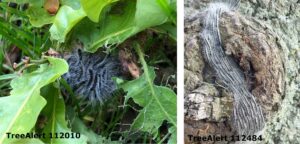
They are a hazard to human and animal health as their hairs can irritate skin, so it is important not to touch or approach the caterpillars or their nests. A poster outlining public information can be found here.
In late Spring and early Summer they are identifiable by their distinctive movement, moving from their nest to feeding areas in processions. They form a line, sometimes multiple caterpillars wide and move together. They can sometimes be seen processing across the ground between oak trees.
Their nests can also be seen on branches or the trunk of the tree and are made from white silk-like material. They range from the size of a golf ball to a rugby ball. Sometimes old OPM nests may remain on oak trees from the previous season. These nests may also harbour a potential health hazard as the caterpillar hairs are likely to still be present within the webbing.
Some of our most common look-a-likes:
-
Brown-tail moth (Euproctis chrysorrhoea) – Native UK Species
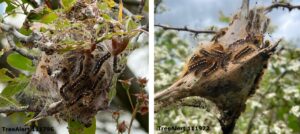
Caterpillars are black and hairy, with white markings down the lateral sides of the body and two distinctive orangey red ‘warts’ towards the tail-end on the back. They are approximately 30 mm long.
Although occasionally found on oaks (Quercus), brown-tail moth larvae are much more common on hedgerow trees such as blackthorn (Prunus) and hawthorn (Crataegus) or on scrubby plants, especially bramble (Rubus). The caterpillars are gregarious feeders being found in large numbers. The white adult moths, with their brown tail have a wingspan of about 35 mm-45 mm and appear in late summer.
Contact with the hairs from brown tail moth caterpillars can cause an itchy skin rash. These hairs can be shed over the plant’s leaves and in the nests that the caterpillars build, although they are often not spread over a great distance unlike those from OPM.
Brown-tail moth caterpillar nests are spun between host twigs in a tent shape. These nests are more likely to be placed on the outer branches of trees/shrubs compared to OPM caterpillars, whose nests are always on the trunk or large branches of oak trees.
-
Lackey moth (Malacosoma neustria) – UK Native Species
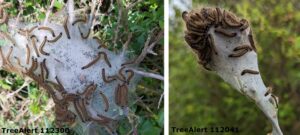
Caterpillars are very brightly coloured with orange, white and blue stripes and are larger than OPM caterpillars, around 40-55 mm when fully grown. The adult moths which are relatively dull in comparison to the larvae have a wingspan of 25 mm-44 mm and will usually be found flying from July to August.
Lackey moth caterpillars feed on a wide variety of plants including, but not limited to; fruit trees such as apple (Malus), pear (Pyrus), plum (Prunus), and wild and ornamental trees and shrubs, including oak (Quercus), rose (Rosa), elm (Ulmus), birch (Betula) and willow (Salix).
The nests of Lackey moth caterpillar are spun between host twigs in a tent shape, in comparison to OPM, which has a rounded nest on the main branches and the trunks of oak trees. They do not present any human health risk but can cause considerable defoliation of the host plant if present in large enough numbers. However, it is often seen that even extensively defoliated shrubs will usually recover by growing a second flush of leaves and so there should not be any significant long-term damage if your plants are found to be affected.
-
Small eggar moth (Eriogaster lanestris) – UK Native Species
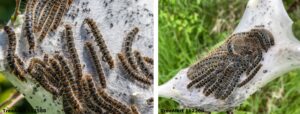
In the early stages of larval development, the caterpillars are small and black. As they mature, caterpillars become velvety-black with red-brown marks that are bordered with white, and are completely covered with fine brown hairs, some of which are quite long. The larvae can grow to approximately 50 mm.
They are found on blackthorn (Prunus) or hawthorn (Crataegus) and not found on oak. Small eggar moth caterpillar nests are spun between host twigs in a tent shape which is similar to other OPM look-a-like species. Whilst the caterpillars are hairy and these can cause irritation to humans the hairs are not shed across host plants and thus direct contact with them is unlikely.
The moths are now not as common as they once were due to habit loss among other factors but can be found in localised areas across the southern counties, Wales and Ireland.
-
Small Ermine Moths (Yponomeuta spp.) – UK Native Species
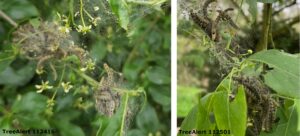
There are 8 different native species of small ermine moth in the UK. Most of the species can be identified by the host plant they feed on. The larvae of the small ermine moths are gregarious feeders and are often first noticed due to the extensive webbing they create which, in extreme cases, can cover the entire host plant. They can be found in large numbers on hawthorn (Crataegus), blackthorn (Prunus), apple (Malus), willow (Salix) and spindle (Euonymous) often in hedgerows. It is their webbed tents which can often be a cause for concern and thus are misidentified as OPM.
The adult moths of most of the UK the species have white wings with black spots, and are tiny with wingspans of 8 mm-33 mm depending on the species.
The hairless caterpillars are cream coloured with lateral black markings and a black head. They are generally no more than 20 mm in length and are not found on oak. The caterpillars offer no threat to human health or to their host plants, except for extensive defoliation they cause. Most plants will recover by the following year.
-
Box tree caterpillar (Cydalima perspectalis) – Asian Species now established in UK
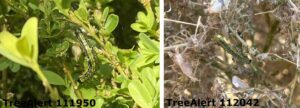
In 2023 we have received large numbers of reports of the Box tree caterpillar. Newly hatched caterpillars are greenish-yellow, with black heads. Older caterpillars have a greenish/yellow body with thick black and thin white stripes along the length of the body and can reach up to 40 mm in length. This introduced species can have 2 generations per year and once established in an area they are known to reoccur each year. The moths are generally white with a brown border and have a wingspan of about 40 mm.
Box tree caterpillars are exclusively found on box (Buxus). The caterpillars eat box leaves, produce webbing over their feeding area and in many cases can cause severe defoliation.
Please visit the RHS website for further information on Box tree caterpillar.
Whilst the presence of large numbers of caterpillars and their webbed tents can sometimes create an immediate cause for concern about the health of their host plants, it is important to remember that many have an intrinsic role in the biodiversity of the environment in which they are found.
Please continue to report caterpillars, especially on oak trees.
Further resources/info:
